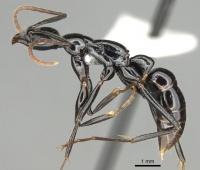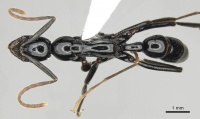Leptogenys kraepelini
| Leptogenys kraepelini | |
|---|---|

| |
| Scientific classification | |
| Kingdom: | Animalia |
| Phylum: | Arthropoda |
| Class: | Insecta |
| Order: | Hymenoptera |
| Family: | Formicidae |
| Subfamily: | Ponerinae |
| Tribe: | Ponerini |
| Genus: | Leptogenys |
| Species group: | chinensis |
| Species: | L. kraepelini |
| Binomial name | |
| Leptogenys kraepelini Forel, 1905 | |
| Subspecies | |
| |
| Synonyms | |
| |
Leptogenys kraepelini is known to nest within rotting wood in young to old growth secondary and shrublands but is seemingly absent from highly disturbed environments. Specimens have been collected either individually or in small groups (three individuals) during the day, with colonies reproducing through ergatoid queens (Ito 1997). Leptogenys kraepelini appears to have a specialised diet on earwigs (Steghaus-Kovac and Maschwitz 1993) but has been observed preying upon termites in Hong Kong (CYLT pers. obs.). (Hamer et al., 2024)
| At a Glance | • Ergatoid queen |
Identification
Hamer et al. (2024) - This species highly resembles Leptogenys peuqueti and Leptogenys grohli within Hong Kong. However, L. kraepelini can be separated from both species by its much larger size, the distinctly posteriorly projecting propodeal lobes and the truncated anterior clypeal margin. Leptogenys kraepelini has been confused with Leptogenys chinensis in the past (Xu and He 2015). However, L. kraepelini has a rectangular head that does not significantly narrow behind the eyes as in L. chinensis; has punctuate sculpture between the clypeus and eyes which L. chinensis lacks, and a straight anterolateral clypeal margin which is sinuate in L. chinensis. More differing characters will likely be revealed upon closer inspection of type material and the examination of more specimens from across the wider region.
Specimens previous determined to be L. chinensis from Guangdong were not examined in this study (Wu et al. 2008; Zhao et al. 2009). Such specimens should be re-examined, especially considering L. kraepelini is now confirmed from Guangdong and Hong Kong (this study), as well as the previously known misidentifications of L. chinensis for L. kraepelini (and L. peuqueti) in the past.
Keys including this Species
- Key to Leptogenys of China
- Key to Leptogenys of Hong Kong
- Key to Oriental Leptogenys
- Keys to Oriental Region Leptogenys chinensis group species
Distribution
Hamer et al. (2024) - Leptogenys kraepelini is widely distributed across Indomalaya, recorded from China (Yunnan and Hong Kong SAR), Vietnam, Laos, Thailand, Malaysia Peninsula, Singapore, Borneo, Sumatra, and Java (Bakhtiar and Chiang 2010; Xu and He 2015; Janicki et al. 2016; Guénard et al. 2017; Khachonpisitsak et al. 2020; Wang et al. 2022). This species is currently absent from many southern Chinese provinces which likely reflects sampling effort in these regions, or has been incorrectly identified as Leptogenys chinensis.
Distribution based on Regional Taxon Lists
Indo-Australian Region: Indonesia (type locality), Singapore.
Oriental Region: Cambodia, Laos, Thailand, Vietnam (type locality).
Palaearctic Region: China.
Distribution based on AntMaps
Distribution based on AntWeb specimens
Check data from AntWeb
Countries Occupied
| Number of countries occupied by this species based on AntWiki Regional Taxon Lists. In general, fewer countries occupied indicates a narrower range, while more countries indicates a more widespread species. |

|
Estimated Abundance
| Relative abundance based on number of AntMaps records per species (this species within the purple bar). Fewer records (to the left) indicates a less abundant/encountered species while more records (to the right) indicates more abundant/encountered species. |

|
Biology
Castes
 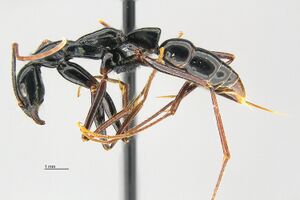 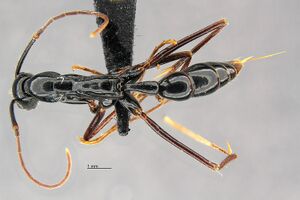 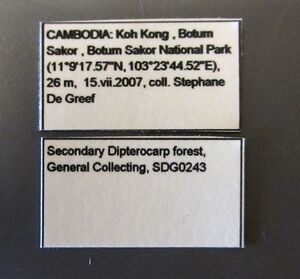
| |
| . | Owned by Museum of Comparative Zoology. |
Nomenclature
The following information is derived from Barry Bolton's Online Catalogue of the Ants of the World.
- kraepelini. Leptogenys (Lobopelta) kraepelini Forel, 1905c: 5 (w.) INDONESIA (Java).
- Type-material: holotype worker.
- Type-locality: Indonesia: Java, Tjibodas, iii.1904 (K. Kraepelin).
- Type-depository: MHNG.
- Karavaiev, 1925c: 280 (m.); Imai, et al. 1985: 46 (k.).
- Status as species: Emery, 1911d: 104; Karavaiev, 1925c: 280 (redescription); Chapman & Capco, 1951: 37; Bolton, 1995b: 232; Jaitrong & Nabhitabhata, 2005: 25; Zhou & Ran, 2010: 105; Bakhtiar & Chiang, 2011: 47 (in key); Xu & He, 2015: 160 (in key) ; Jaitrong, Guénard, et al. 2016: 42; Wachkoo, Maqbool, et al. 2018: 7 (in key); Arimoto & Yamane, 2018: 29 (in key).
- Senior synonym of baccha: Xu & He, 2015: 142.
- Distribution: China, Indonesia (Java), Laos, Malaysia (Sabah), Thailand, Vietnam.
- Current subspecies: nominal plus esae, nero.
- baccha. Leptogenys (Lobopelta) kraepelini st. baccha Santschi, 1919a: 336 (w.) VIETNAM.
- Type-material: 2 syntype workers.
- Type-locality: Vietnam: Tonkin, Chapa (V. de Salvaza).
- Type-depository: NHMB.
- Subspecies of kraepelini: Santschi, 1920h: 159; Santschi, 1924c: 97; Chapman & Capco, 1951: 37; Bolton, 1995b: 230; Zhou & Ran, 2010: 106.
- Junior synonym of kraepelini: Xu & He, 2015: 142.
Description
Karyotype
- See additional details at the Ant Chromosome Database.
 Explore: Show all Karyotype data or Search these data. See also a list of all data tables or learn how data is managed.
Explore: Show all Karyotype data or Search these data. See also a list of all data tables or learn how data is managed.
- n = 13, 2n = 26 (Indonesia) (Imai et al., 1985; Mariano et al., 2015).
References
- Forel, A. 1905f. Ameisen aus Java. Gesammelt von Prof. Karl Kraepelin 1904. Mitteilungen aus dem Naturhistorischen Museum in Hamburg 22: 1-26. (page 5, worker described)
- Hamer, M.T., Lee, J.H.C., Tse, C.Y.L., Silva, T.S.R., Guénard, B. 2024. The Leptogenys Roger, 1861 (Formicidae, Ponerinae) of Hong Kong SAR with additional records from Guangdong, China. ZooKeys 1202, 169–211 (doi:10.3897/zookeys.1202.120214).
- Imai, H. T.; Kubota, M.; Brown, W. L., Jr.; Ihara, M.; Tohari, M.; Pranata, R. I. 1985. Chromosome observations on tropical ants from Indonesia. Annu. Rep. Natl. Inst. Genet. Jpn. 35: 46-48 (page 46, karyotype described)
- Karavaiev, V. 1925c. Ponerinen (Fam. Formicidae) aus dem Indo-Australischen Gebiet. (Schluss). Konowia 4: 276-296 (page 280, male described)
- Mariano, C.S.F., Santos, I.S., Silva, J.G., Costa, M.A., Pompolo, S.G. 2015. Citogenética e evolução do cariótipo em formigas poneromorfas. In: Delabie, J.H.C., Feitosa, R.M., Serrao, J.E., Mariano, C.S.F., Majer, J.D. (eds) As formigas poneromorfas do Brasil, 1st edn. Ilhéus, Brasil, pp 102–125 (doi:10.7476/9788574554419.0010).
- Satria, R., Nugraha, F.A.D., Achyar, A., Zulyetti, D., Eguchi, K. 2024, Description of the male caste of Leptogenys borneensis (Hymenoptera, Formicidae), with its first discovery in Sumatra. Zoodiversity 58 (1), 19-26 (doi:10.15407/zoo2024.01.19).
- Wang, W.Y., Soh, E.J.Y., Yong, G.W.J., Wong, M.K.L., Benoit Guénard, Economo, E.P., Yamane, S. 2022. Remarkable diversity in a little red dot: a comprehensive checklist of known ant species in Singapore (Hymenoptera: Formicidae) with notes on ecology and taxonomy. Asian Myrmecology 15: e015006 (doi:10.20362/am.015006).
- Xu, Z. & He, Q. 2015. Taxonomic review of the ponerine ant genus Leptogenys Roger, 1861 with a key to the Oriental species. Myrmecological News 21: 137-161.
References based on Global Ant Biodiversity Informatics
- Bakhtiar E.Y., and S.L. Chiang. 2010. Leptogenys ants (Hymenoptera: Formicidae: Ponerinae) of Sabah. Serangga 15(1-2): 37-55.
- Chapman, J. W., and Capco, S. R. 1951. Check list of the ants (Hymenoptera: Formicidae) of Asia. Monogr. Inst. Sci. Technol. Manila 1: 1-327
- Eguchi K., B. T. Viet, and S. Yamane. 2014. Generic Synopsis of the Formicidae of Vietnam (Insecta: Hymenoptera), Part IICerapachyinae, Aenictinae, Dorylinae, Leptanillinae, Amblyoponinae, Ponerinae, Ectatomminae and Proceratiinae. Zootaxa 3860: 001-046.
- Emery C. 1911. Hymenoptera. Fam. Formicidae. Subfam. Ponerinae. Genera Insectorum 118: 1-125.
- Fontanilla A. M., A. Nakamura, Z. Xu, M. Cao, R. L. Kitching, Y. Tang, and C. J. Burwell. 2019. Taxonomic and functional ant diversity along tropical, subtropical, and subalpine elevational transects in southwest China. Insects 10, 128; doi:10.3390/insects10050128
- Forel A. 1905. Ameisen aus Java. Gesammelt von Prof. Karl Kraepelin 1904. Mitt. Naturhist. Mus. Hambg. 22: 1-26.
- Imai H. T., M. Kubota, W. L. Brown, Jr., M. Ihara, M. Tohari, and R. I. Pranata. 1985. Chromosome observations on tropical ants from Indonesia. Annu. Rep. Natl. Inst. Genet. Jpn. 35: 46-48.
- Jaitrong W., B. Guenard, E. P. Economo, N. Buddhakala, and S. Yamane. 2016. A checklist of known ant species of Laos (Hymenoptera: Formicidae). Asian Myrmecology 8: 1-32. DOI: 10.20362/am.008019
- Jaitrong W., and T. Ting-Nga. 2005. Ant fauna of Peninsular Botanical Garden (Khao Chong), Trang Province, Southern Thailand (Hymenoptera: Formicidae). The Thailand Natural History Museum Journal 1(2): 137-147.
- Jaitrong W.; Nabhitabhata, J. 2005. A list of known ant species of Thailand. The Thailand Natural History Museum Journal 1(1): 9-54.
- Karavaiev V. 1925. Ponerinen (Fam. Formicidae) aus dem Indo-Australischen Gebiet. (Schluss). Konowia 4: 276-296.
- Karavaiev V. 1926. Ameisen aus dem Indo-Australischen Gebiet. Treubia 8: 413-445.
- Lopwichan S., and S. Khachonpisitsak. 2015. Ant diversity in Nong Tha Yu Arboretum, Si Racha District, Chon Buri Province. Proceedings The 7 th National Science Research Conference. 30-31 March 2015. Naresuan University.
- Ogata K. 2005. Asian ant inventory and international networks. Report on Insect inventory Project in Tropic Asia TAIIV: 145-170.
- Philpott S.M., P. Bichier, R.A. Rice, and R. Greenberg. 2008. Biodiversity conservation, yield, and alternative products in coffee agroecosystems in Sumatra, Indonesia. Biodivers. Conserv. 17: 1805-1820. Data obtained from Stacy Philpott
- Xu Z. H., and Q. J. He. 2015. Taxonomic review of the ponerine ant genus Leptogenys ROGER, 1861 (Hymenoptera: Formicidae) with a key to the Oriental species. Myrmecological News 21: 137-161.
- Yamane S.; Bui T. V.; Ogata K.; Okido H.; Eguchi K. 2002. Ant fauna of Cuc Phuong National Park, North Vietnam (Hymenoptera: Formicidae). Bulletin of the Institute of Tropical Agriculture Kyushu University 25: 51-62.
